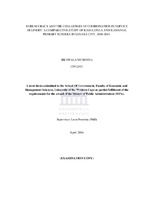| dc.contributor.advisor | Pretorius, Leon | |
| dc.contributor.author | Musonda, Sikawala | |
| dc.date.accessioned | 2017-09-19T14:37:08Z | |
| dc.date.available | 2017-09-19T14:37:08Z | |
| dc.date.issued | 2016 | |
| dc.identifier.uri | http://hdl.handle.net/11394/5584 | |
| dc.description | Masters in Public Administration - MPA | en_US |
| dc.description.abstract | The study Bureaucracy and the challenges of coordination in service delivery: A comparative study of Kamanga and Kabulonga Primary Schools in Lusaka City 2010- 2014 had the main aim of finding out the challenges encountered in the coordination of primary education within Lusaka City. The study was attempting to draw lessons and understand why schools within the same district and level (primary) were performing differently. There are many reasons as to why the study is important. To begin with, the information derived from this study is important in the post MDG implementation period after the end of the implementation period in 2015. Second, no research has been done on organizational design and development in the context of Africa and Zambia. While some scholars have published on education management, the aspect of bureaucratic coordination has not been adequately addressed. The study took a comparative approach to research. Qualitative research was deployed as means of carrying out the study. Both primary and secondary data were used. Primary data was collected from two schools which were sampled purposively. The researcher approached the District education office to recommend two schools (one performing well and another underperforming one). The two schools recommended are Kabulonga Primary and Kamanga Primary respectively. A sample of seven experts was then extracted including two teachers from each school, a school manager for each school and the district planning officer at district level. Data was collected using semi structured interview guides between December 2015 and January 2016. Data was collected through a recorder, transcribed and analyzed using thematic analysis. On the other hand, secondary data was obtained from policy, legal, government and internal documents. Among the major findings was that the school's locations or environments have a major impact on how they function. For instance Kabulonga performed better than Kamanga because the latter is in an area where majority are low earning poor households. Further, internally, the ability of Kabulonga to plan in a long term manner enabled the school to match resources with specific priorities, something Kamanga did not do. Furthermore, the avenues used for communication in the district have got poor information feedback mechanisms. The study thus recommended that the government should distribute resources to schools with a connotation of giving an extra financial bell out to those schools operating in poverty stricken areas since such schools cannot find other means of survival. | en_US |
| dc.language.iso | en | en_US |
| dc.publisher | University of the Western Cape | en_US |
| dc.subject | Bureaucracy | en_US |
| dc.subject | School management and organization | en_US |
| dc.subject | Education management | en_US |
| dc.subject | Organizational development | en_US |
| dc.subject | Zambia | en_US |
| dc.subject | Primary education | en_US |
| dc.title | Bureaucracy and the challenges of coordination in service delivery : a comparative study of Kabulonga and Kamanga primary schools in Lusaka City, 2010- 2014 | en_US |
| dc.rights.holder | University of the Western Cape | en_US |

